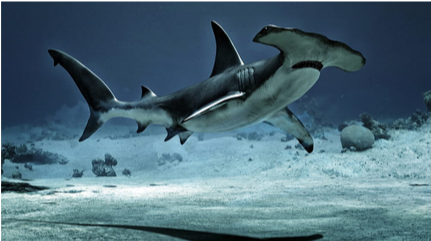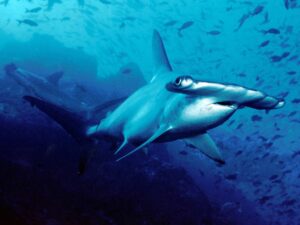Oh, the elusive Hammerhead shark….
“Let’s go diving and see one!”
“Ha! Yah right, in Cozumel?”
“Well of course! Why not? Just think of the bragging rights.”
That was me, a few years ago… never in a thousand years did I think I would be lucky enough to see one…
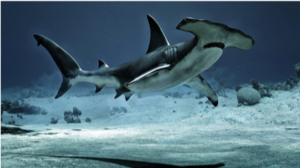 Hammerheads are the most unique shark in the ocean. They have an unusual and distinctive flat T-shaped head(cephalofoil), with the eyes located on the ends of the tips. They also have an extra tall pointed dorsal fins. Their beautiful grey/green bodies with white stripes and white bellies help hide them from below and above. They really stand out!
Hammerheads are the most unique shark in the ocean. They have an unusual and distinctive flat T-shaped head(cephalofoil), with the eyes located on the ends of the tips. They also have an extra tall pointed dorsal fins. Their beautiful grey/green bodies with white stripes and white bellies help hide them from below and above. They really stand out!A quick Google will usually tell you there are 9 species of Hammerhead and, let’s be real, that’s where most people stop. In actuality, there are 10 species of hammerhead sharks. The reason for the confusion isn’t a scientific debate, it’s simply because the 10th species is a fairly recent discovery.
The Carolina hammerhead (Sphyrna gilberti) was discovered in 1967 but wasn’t formally described and recognized until 2013. They get their name because their pups grow up in, you guessed it, Carolina. As they get older their range expands, although they stay in the Western Atlantic Ocean. (https://oceansyrup.com/hammerhead-shark-head-types/)
Most hammerheads are quite small, but sizing ranges from 3 to 20 ft (0.9 – 6.0 m) in length and 6 to 1280 lbs (6.6 to 580Kg) in weight. The largest of course is… the Great Hammerhead. Hammerheads belong to the Sphyrnidae family and there are 10 species.
- Winghead Shark
- Scalloped Bonnethead
- Whitefin Hammerhead
- Scalloped Hammerhead
- Scoophead
- Great Hammerhead
- Bonnethead
- Smalleye Hammerhead
- Smooth Hammerhead
- Carolina Hammerhead
Hammerheads are considered one of the most recently evolved groups of sharks, dating back in the fossil record to at least the 23 million years ago, with some authorities believing they emerged as early as 56 million years ago. That is crazy old.
Most hammerheads swim in schools during the day and hunt solo at night. (However, most, if not all sighting in Cozumel are solo.) You can find Hammerheads in tropical waters near coasts or along shelves all over the world. Hammerheads eat a large range of prey, including other sharks, squid, octopus, crustaceans and their favorite sting rays. (Yes, they will eat our favorite eagle rays.) They use their unique hammerhead design to ram and hold them down, then dinner is served….sorry.
As with all sharks, they use electroreceptor sensory pores, which detect electricity given off by other creatures. Their T-shaped heads provide them with a much larger sensory area than other sharks. With eyes at the end of the T’s, they have a 360 degree view to help find that prey more effectively.
Come mating time, (once a year) males will bite the female until she gives in. (Youch!) See our article and video on Shark Reproduction.
Hammerhead sharks are viviparous meaning they retain fertilized eggs within the body and give birth to live young. Anywhere from 2 pups in the smaller species of sharks to a couple of dozen with the great hammerhead. Birth usually occurs during the spring and summer months, and females will usually give birth in shallow, protected coastal waters. The pups will stay together in warm water until they are big enough to go out on their own. No parenting involved. (Yay!)
The great Hammerhead is the largest of all of the species, and tends to be the more aggressive shark, even eating its own young. Only 17 human unprovoked attacks have ever been recorded worldwide, but they have been known to attack to defend themselves.
Since shark fins are considered a delicacy, Hammerheads were placed on the endangered list in 2013.
Hawaiians believe the Hammerhead (aumakua) watches and protects them. An aumakua, is a birth animal, a sign of a great warrior and meant to sail the seas. I am lucky enough to have bragging rights, yep a hammerhead while diving in Cozumel (yes, my buddy and DM saw it too!). But if you have been unsuccessful in seeing the elusive hammerhead while diving, the Georgia Aquarium in Atlanta has one you can go watch…..
Thank you Maralee Bailey for putting together such a wonderful article.
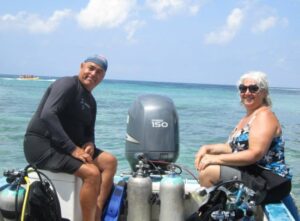
Now, Maralee is not the only customer that can BRAG about seeing the hammerhead in Cozumel. The Petersons (Ray and Vicki, Randy and Lori) also saw one in Feb 2014, and have the pictures to prove it ! They were diving on Palancar Bricks with Rudy. And exactly 1 week later, Rudy was back diving on the same reef with a different group of divers and guess what – they saw her again. I say her because it is thought that the hammerheads that are seen here come to give birth, although we have never seen baby hammerheads so…. Not sure if that is really true or not, but that is what I am told.
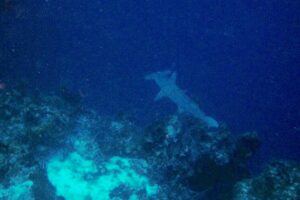
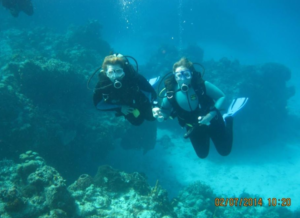
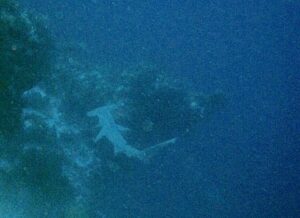
Thank you Vicki and Lori Peterson for sharing your pictures taken here in Cozumel with us !

